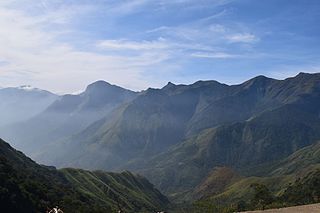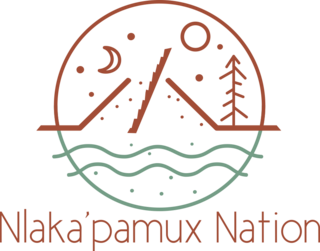
The Himalayas, or Himalaya, are a mountain range in Asia, separating the plains of the Indian subcontinent from the Tibetan Plateau. The range has some of the planet's highest peaks, including the highest, Mount Everest. Over 100 peaks exceeding 7,200 m (23,600 ft) in elevation lie in the Himalayas. By contrast, the highest peak outside Asia is 6,961 m (22,838 ft) tall.

Yosemite National Park is an American national park in California, surrounded on the southeast by Sierra National Forest and on the northwest by Stanislaus National Forest. The park is managed by the National Park Service and covers an area of 759,620 acres and sits in four counties – centered in Tuolumne and Mariposa, extending north and east to Mono and south to Madera County. Designated a World Heritage Site in 1984, Yosemite is internationally recognized for its granite cliffs, waterfalls, clear streams, giant sequoia groves, lakes, mountains, meadows, glaciers, and biological diversity. Almost 95 percent of the park is designated wilderness. Yosemite is one of the largest and least fragmented habitat blocks in the Sierra Nevada, and the park supports a diversity of plants and animals.

The Maidu are a Native American people of northern California. They reside in the central Sierra Nevada, in the watershed area of the Feather and American rivers. They also reside in Humbug Valley. In Maiduan languages, Maidu means "man."

Valley of Flowers National Park is an Indian national park which was established in 1982. It is located in Chamoli in the state of Uttarakhand and is known for its meadows of endemic alpine flowers and the variety of flora. This richly diverse area is also home to rare and endangered animals, including the Asiatic black bear, snow leopard, musk deer, brown bear, red fox and blue sheep. Birds found in the park include Himalayan monal pheasant and other high altitude birds.

The Yuki are an indigenous people of California, whose traditional territory is around Round Valley, Mendocino County. Today they are enrolled members of the Round Valley Indian Tribes of the Round Valley Reservation. Before the arrival of Europeans, the Yuki called themselves "Ukomno'om," meaning "valley people." The exonym "Yuki" may derive from the Wintu word meaning "foreigner" or "enemy."

The Ahwahnechee are a Native American people who traditionally lived in the Yosemite Valley and still live in surrounding area. They are the seven tribes of Yosemite Miwok, Northern Paiute, Kucadikadi Mono Lake people. As one of the most documented tribes the tribe still fights for Federal Recognition. The Ahwahnechee people's heritage can be found all over Yosemite National Park.

Indian Point Energy Center (I.P.E.C.) is a three-unit nuclear power plant station located in Buchanan, just south of Peekskill, in Westchester County, New York. It sits on the east bank of the Hudson River, about 36 miles (58 km) north of Midtown Manhattan. The facility has permanently ceased power operations as of April 30, 2021. Before its closure, the station's two operating reactors generated about 2,000 megawatts (MWe) of electrical power, about 25% of New York City's usage. The station is owned by Holtec International, and consists of three permanently deactivated reactors, Indian Point Units 1, 2, and 3. Units 2 and 3 were Westinghouse pressurized water reactors. Entergy purchased Unit 3 from the New York Power Authority in 2000 and Units 1 and 2 from Consolidated Edison in 2001.

Silent Valley National Park is a national park in Kerala, India. It is located in the Nilgiri hills, has a core area of 89.52 km2 (34.56 sq mi), which is surrounded by a buffer zone of 148 km2 (57 sq mi). This national park has some rare species of flora and fauna. This area was explored in 1847 by the botanist Robert Wight. It is located in the border of Mannarkkad Taluk of Palakkad district, Nilambur Taluk of Malappuram district, Kerala, and Nilgiris district of Tamil Nadu.

The Patwin are a band of Wintun people native to the area of Northern California. The Patwin comprise the southern branch of the Wintun group, native inhabitants of California since approximately 500 AD.

Sri Venkateswara National Park is a national park and biosphere reserve in Andhra Pradesh, India. The total area of the park is 353 km2. The park is known for its many waterfalls, including the Talakona, Gundalakona and Gunjana. As the government of India declared the Seshachalam Hills as one of the biosphere reserves of India in 2010, this national park becomes the part of it.

Pin Valley National Park is a National park of India located in the Spiti Valley in the Lahaul and Spiti district, in the state of Himachal Pradesh. It is located in far northern India. It is part of Cold Desert.

The Neelum River, or Kishanganga, is a river in the Kashmir region of India and Pakistan. It originates in the north of Indian Jammu and Kashmir, flows through the Neelam District of Pakistan's Azad Kashmir and then merges with the Jhelum River near the city of Muzaffarabad.

Most of the food items which define modern North Indian and Subcontinental cooking have origins inside the Indian subcontinent though many foods that are now a part of them are based on fruits and vegetables that originated outside the Indian subcontinent.

The Lower Colorado River Valley (LCRV) is the river region of the lower Colorado River of the southwestern United States in North America that rises in the Rocky Mountains and has its outlet at the Colorado River Delta in the northern Gulf of California in northwestern Mexico, between the states of Baja California and Sonora. This north–south stretch of the Colorado River forms the border between the U.S. states of California/Arizona and Nevada/Arizona, and between the Mexican states of Baja California/Sonora.

Coles Creek culture is a Late Woodland archaeological culture in the Lower Mississippi valley in the Southeastern Woodlands. It followed the Troyville culture. The period marks a significant change in the cultural history of the area. Population increased dramatically and there is strong evidence of a growing cultural and political complexity, especially by the end of the Coles Creek sequence. Although many of the classic traits of chiefdom societies are not yet manifested, by 1000 CE the formation of simple elite polities had begun. Coles Creek sites are found in Arkansas, Louisiana, and Mississippi. It is considered ancestral to the Plaquemine culture.
Farmana Khas or Daksh Khera is an archaeological site in Meham block of Rohtak district in northern Indian state of Haryana spread over 18.5 hectares. It is located near the village of Farmana Khas, about 15 kilometers from the Rohtak-Hissar highway and 60 kilometres from Delhi. It is significant particularly for its burial site, with 70 burials, of the Mature Harappan period (2500–2000 BC) and fairly recent addition to Indus Valley Civilisation sites excavated in India.

The Nlaka'pamux or Nlakapamuk, also previously known as the Thompson, Thompson River Salish, Thompson Salish, Thompson River Indians or Thompson River people, and historically as the Klackarpun, Haukamaugh, Knife Indians, and Couteau Indians, are an Indigenous First Nations people of the Interior Salish language group in southern British Columbia. Their traditional territory includes parts of the North Cascades region of Washington.

The Troyville culture is an archaeological culture in areas of Louisiana and Arkansas in the Lower Mississippi valley in the Southeastern Woodlands. It was a Baytown Period culture and lasted from 400 to 700 CE during the Late Woodland period. It was contemporaneous with the Coastal Troyville and Baytown cultures and was succeeded by the Coles Creek culture. Where the Baytown peoples built dispersed settlements, the Troyville people instead continued building major earthwork centers.
Balu is a small archeological site attributed to the Indus Valley Civilisation, located some 22 kilometres (14 mi) south of the city of Kaithal in the Indian state of Haryana. There are three Patti in village.There exists many castes in the village, most among them are Hindu Jats, mainly Bidhan, Rapria and Boora. It is one of the biggest villages of Haryana and has three sarpanchs According to Census 2011, Balu has population of nearly 16,000 and nearly 2,800 houses residing. There are various facilities in village consists of hospital, power house, schools and transport services. Mostly, people of the village lives well above poverty and healthy environment.

The Deer Park, Hisar, on Hisar-Dhansu in Hisar city of Haryana state in India has an area of 19 hectares including a 6-acre plot for producing fodder for the deer. Park as 4 species, blackbuck, chital spotted deer and 6 sambar. It also doubles up as the wildlife rescue clinic for the treatment injured wild animals and birds brought here by the people, which are released back in to the wild after the recovery.


















